The German Reich and the Second World War
- Thread starter enigmamcmxc
- Start date
-
We have updated our Community Code of Conduct. Please read through the new rules for the forum that are an integral part of Paradox Interactive’s User Agreement.
You are using an out of date browser. It may not display this or other websites correctly.
You should upgrade or use an alternative browser.
You should upgrade or use an alternative browser.
I'll be happy to see an update when you're back from vacation and all rested and relaxed.
No vacation is required. *whip*
Which reminds me.... where's that epilogue you were writing? *whip* *whip* *whip* *whip* *whip*
Thanks everyone for the comments!
LoftenHenderson: At the moment, they consist of just a single engineer unit. Since i was unsure how best to incorporate engineers into this game (in Vicky2 every army had an engineer unit, and when i have played as the UK in the past in regular HOI3 i usually tried to have an engineer unit per division) due to the large number of units, i have kept them seperate and have just employed them when and where i need them: river crossings, urban battles etc. So far i am seeing mixed results.
LoftenHenderson: At the moment, they consist of just a single engineer unit. Since i was unsure how best to incorporate engineers into this game (in Vicky2 every army had an engineer unit, and when i have played as the UK in the past in regular HOI3 i usually tried to have an engineer unit per division) due to the large number of units, i have kept them seperate and have just employed them when and where i need them: river crossings, urban battles etc. So far i am seeing mixed results.
July

Persia, following the Anglo-Soviet attack, now a puppet
and forced into war with the Reich.
During June, it became very obvious that Army Group South lacked enough infantry to complete its mission. At the end of the month, after much debate at OKH, it was decided to temporarily transfer Eighth Army, from Army Group Centre, to Army Group South. Army Group South, now reinforced, should then be able to complete its original mission of trapping the bulk of the southern Soviet Army Group (estimated at around 200,000 men) in a pocket against the Hungarian-Rumanian border. Furthermore, the newly raised 38 Corps (218, 222, 223 divisions) was also assigned to Army Group South, raising the group’s total number of divisions to 38.
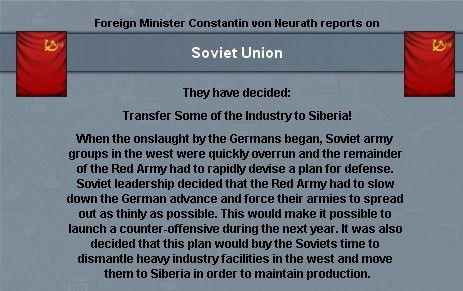
Rumours, later confirmed via interrogated prisoners, suggested the Soviets
started moving industrial equipment soon after the start of our defensive war.
The first week of July saw Army Group Centre capture the Soviet Nuclear Research facility, at Sarny, intact albeit heavily damaged. Days later, on 8 July, Panzer Group 1 and 2 breached the Stalin Line in numerous locations. The armour had greatly outpaced the infantry, so while most divisions were stood down to hold the line until relieved; three panzer divisions were still available to carry on the advance. They were unleashed to keep up the pressure on the Soviet forces and to attempt to capture Smolensk. While this new drive was being organised, Soviet troops – having fought off a northern flanking thrust - withdrew from Minsk giving up the city and keeping their, what turned out to be, small garrison intact. As the infantry caught up with the front, the panzers again pushed forward.
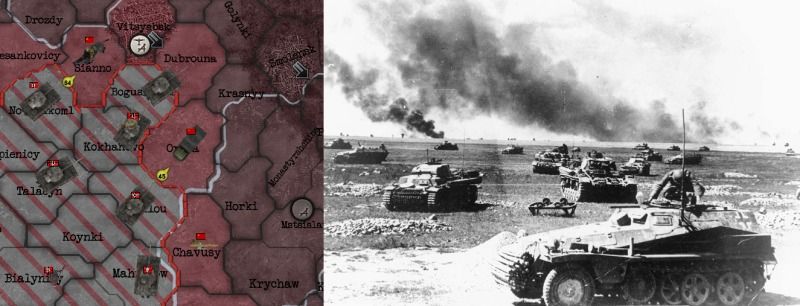
The panzers of Army Group Centre.
In an effort to achieve what Panzer Group 3 failed to do, Eighth Army marched down the narrow corridor to launch an attack on the southern end of the Stalin Line in an effort to rapidly breach it. The corridor was still coming under attack from all sides causing numerous delays in moving Eighth Army forward. Only then, did it draw on von Bock that attempting to widen the corridor should have been his first priority. As the month wore on, garrison divisions and then the strategic reserve (the paratroopers and mountain divisions) were also ordered to reinforce Army Group South, further increasing its number to 46 divisions. In the meantime, having finally concentrated at the tip of the corridor, Eighth Army had to fend off a massive Soviet counterattack aimed at them.

Infantry clear out a forest bunker, part of the Stalin Line.
On 22 July, as various panzer divisions started to encircle Smolensk, a coup de main attack to take the city failed. The Soviet garrison halted the leading panzer company, resulting in the panzer division pulling back to await the completion of the encirclement and for infantry to catch up. However, only four days later, the city was taken without a fight as the Red Army garrison withdrew before it became trapped. A critical point the campaign had now been reached.
Army Group Centre now lacked the infantry strength to hold the line and free up the panzers to allow the advance on Moscow to continue, especially at this point when Soviet resistance seemed to have crumbled in the centre. The transfer of Eighth Army, while required to strength the southern attack, had resulted in a massive strategic blunder in the centre. The original plan had envisioned that Army Group South and North would have cleared out both flanks, thus freeing up enough infantry so to keep pushing forward. Now, it would seem, to free up the required numbers to carry on the advance, Panzer Group 1 and 2 would need to be transferred from Army Group Centre to the flanking army groups to straighten out the frontline.
The end of the month brought at least some good news. Eighth Army, having fended off all Soviet counterattacks, finally penetrated the Stalin Line and rapidly crossed the Dniester River. After two months of fighting, Army Group South had finally achieved their first objective.
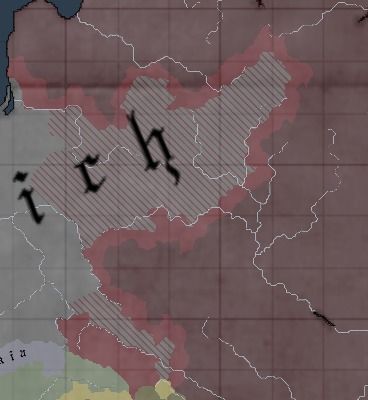
The frontline at the end of the month.
Losses for both sides, throughout the month, were somewhat similar to June, although no large haul of Soviet prisoners were taken. Around 300 Soviet planes had been shot down, and due to the decrease in the presence of the Red Air Force the losses of the Luftwaffe were less than 200.

Persia, following the Anglo-Soviet attack, now a puppet
and forced into war with the Reich.
During June, it became very obvious that Army Group South lacked enough infantry to complete its mission. At the end of the month, after much debate at OKH, it was decided to temporarily transfer Eighth Army, from Army Group Centre, to Army Group South. Army Group South, now reinforced, should then be able to complete its original mission of trapping the bulk of the southern Soviet Army Group (estimated at around 200,000 men) in a pocket against the Hungarian-Rumanian border. Furthermore, the newly raised 38 Corps (218, 222, 223 divisions) was also assigned to Army Group South, raising the group’s total number of divisions to 38.

Rumours, later confirmed via interrogated prisoners, suggested the Soviets
started moving industrial equipment soon after the start of our defensive war.
The first week of July saw Army Group Centre capture the Soviet Nuclear Research facility, at Sarny, intact albeit heavily damaged. Days later, on 8 July, Panzer Group 1 and 2 breached the Stalin Line in numerous locations. The armour had greatly outpaced the infantry, so while most divisions were stood down to hold the line until relieved; three panzer divisions were still available to carry on the advance. They were unleashed to keep up the pressure on the Soviet forces and to attempt to capture Smolensk. While this new drive was being organised, Soviet troops – having fought off a northern flanking thrust - withdrew from Minsk giving up the city and keeping their, what turned out to be, small garrison intact. As the infantry caught up with the front, the panzers again pushed forward.

The panzers of Army Group Centre.
In an effort to achieve what Panzer Group 3 failed to do, Eighth Army marched down the narrow corridor to launch an attack on the southern end of the Stalin Line in an effort to rapidly breach it. The corridor was still coming under attack from all sides causing numerous delays in moving Eighth Army forward. Only then, did it draw on von Bock that attempting to widen the corridor should have been his first priority. As the month wore on, garrison divisions and then the strategic reserve (the paratroopers and mountain divisions) were also ordered to reinforce Army Group South, further increasing its number to 46 divisions. In the meantime, having finally concentrated at the tip of the corridor, Eighth Army had to fend off a massive Soviet counterattack aimed at them.
Infantry clear out a forest bunker, part of the Stalin Line.
On 22 July, as various panzer divisions started to encircle Smolensk, a coup de main attack to take the city failed. The Soviet garrison halted the leading panzer company, resulting in the panzer division pulling back to await the completion of the encirclement and for infantry to catch up. However, only four days later, the city was taken without a fight as the Red Army garrison withdrew before it became trapped. A critical point the campaign had now been reached.
Army Group Centre now lacked the infantry strength to hold the line and free up the panzers to allow the advance on Moscow to continue, especially at this point when Soviet resistance seemed to have crumbled in the centre. The transfer of Eighth Army, while required to strength the southern attack, had resulted in a massive strategic blunder in the centre. The original plan had envisioned that Army Group South and North would have cleared out both flanks, thus freeing up enough infantry so to keep pushing forward. Now, it would seem, to free up the required numbers to carry on the advance, Panzer Group 1 and 2 would need to be transferred from Army Group Centre to the flanking army groups to straighten out the frontline.
The end of the month brought at least some good news. Eighth Army, having fended off all Soviet counterattacks, finally penetrated the Stalin Line and rapidly crossed the Dniester River. After two months of fighting, Army Group South had finally achieved their first objective.

The frontline at the end of the month.
Losses for both sides, throughout the month, were somewhat similar to June, although no large haul of Soviet prisoners were taken. Around 300 Soviet planes had been shot down, and due to the decrease in the presence of the Red Air Force the losses of the Luftwaffe were less than 200.
Last edited:
*snip*On 22 July, as various panzer divisions started to encircle Smolensk, a coup de main attack to take the city failed. The Soviet garrison halted the leading panzer company, and the division soon pulled back to await the completion of the encirclement and for infantry to catch up. However, only four days later, the city was taken without a fight as the garrison withdrew before it became trapped. A critical point the campaign had now been reached.*snip*
Don't you find that frustrating? I mean I guess that might be considered a wise strategic move (to withdraw from the city) but it's a city garrison. I'd expect it to defend the city to the last man especially as Russians. I've seen similar things happen at Moscow which I find galling. Makes life easier for you though
I'm very happy to see you back from your vacation and updating again enigmamcmxc. Sounds like Army Group South could take some lessons from Centre, but instead they've stolen some troops...and created quite a problem. At least you're still in the good weather period. I'm sure you're hustling to progress as far as possible before General Winter shows up.
I believe it is the third time the Soviet AI has done it now, but Smolensk espeically is a VP. I was expecting a bigger fight but maybe it has something to do with the fact most of the AI forces seems to be on my flanks, so there was no support?
Stolen some troops? I have somehow created a vacuum and its sucking up all my troops! As soon as the mud hits, am thinking of racking the difficulty level further up, and prehaps - since i opted out of an alliance with the Japanese (am sure) - causing the Pacific War and modding the US into the Allies.
Stolen some troops? I have somehow created a vacuum and its sucking up all my troops! As soon as the mud hits, am thinking of racking the difficulty level further up, and prehaps - since i opted out of an alliance with the Japanese (am sure) - causing the Pacific War and modding the US into the Allies.
I was referring to this....perhaps "stolen" wasn't quite the right word but I'm sure for the commander of AG Centre it felt that way...especially later when he lacked needed infantry.During June it became very obvious that Army Group South lacked enough infantry to complete its mission. At the end of the month, after much debate at OKH, it was decided to temporarily transfer Eighth Army, from Army Group Centre, to Army Group South. Army Group South, now reinforced, should then be able to complete its original mission of trapping the bulk of the southern Soviet Army Group (estimated at around 200,000 men) in a pocket against the Hungarian-Rumanian border. Furthermore, the newly raised 36 Corps (218, 222, 223 divisions) was also assigned to Army Group South, raising the group’s total number of divisions to 38.
Oh deffo! If i was he  laugh
laugh i would be well pissed. So close to the ultimate objective only to find, that those troops you were earlier screwed out of, would be realy handy right about now to win the war!
i would be well pissed. So close to the ultimate objective only to find, that those troops you were earlier screwed out of, would be realy handy right about now to win the war!
I have a feeling, he will have more and more reasons to feel pissed off shortly :happy:
I have a feeling, he will have more and more reasons to feel pissed off shortly :happy:
August: Strategy falters
The end of July saw the battle plan for the campaign falter, due to earlier strategic decisions. Unable to support any further advance of Army Group Centre, who were now holding a 400-mile long front, Field Marshal von Rundstedt called its commanding officer during the early hours of 1 August. No record of the conversation exists, but it is believed the aging commander informed von Kluge "The advance is no longer sustainable; you are to halt, hold the line, and relinquish commander of the panzers. There is no room for discussion." Whatever the actual wording of the conversation, various staff officers within the army group have gone on record to say that following the phone call von Kluge was "not in the best of moods". Within the space of a few minutes Army Group Centre, once the strongest formation Germany had put into the field, had been reduced to a mere 24 divisions.
While the termination of Army Group Centre’s advance was a blow to the prestige of von Kluge – with ambitions of co-ordinating the capture of the Soviet capital – it was the correct decision in regards to the strategic situation. All infantry reserves, other than a few divisions still forming within the Reich, had been allocated to Barbarossa and there was nothing left to support the continued drive on Moscow. Under its own power Army Group North was not able to inflict a devastating defeat upon the northern Soviet armies, nor was it able to clear out the Baltic States and secure the flank of Army Group Centre. In an effort to achieve these goals, and shorten the frontline, Panzer Group 1 and 2 would be transferred north. It would however take these 12 divisions two weeks to be relieved, move back into reserve and be available to strike towards the Baltic.
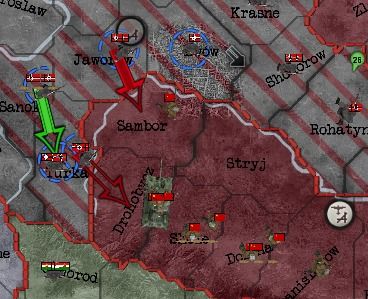
The German attacks along the northern edge of the pocket.
Meanwhile in the south, an untold number of Soviet divisions were still trapped in what had by now become known as the 'Dniester pocket'. Blaskowitz, commanding the southern army group, had created a relatively weak blocking position to the south of the pocket and now assembled 16 divisions (out of the 46 he now controlled) to hammer away at the northern end of the pocket driving the defending Russian troops south into the waiting hands of his 'anvil'. During the first two weeks of the month, this stratagem worked well. Position after position, along the northern ends of the pocket, were captured, and desperate Soviet soldiers launched themselves daily upon the German blocking position that was barring their way to freedom. Two German divisions, dug-in and manning roadblocks with well-sited machine gun and artillery positions, was all that stood between them and escape. On a daily basis, for the entire month, these troops held their position and hammered away at the desperate Soviet forces during attempted breakout. The raising body count did not deter further efforts the next day, or the day after. With the Red Army trapped within the Dniester pocket no longer posing a threat to the corridor, Blaskowitz now launched numerous attacks to expand his frontline and unleashed his panzers south through a gap in the line into undefended territory.
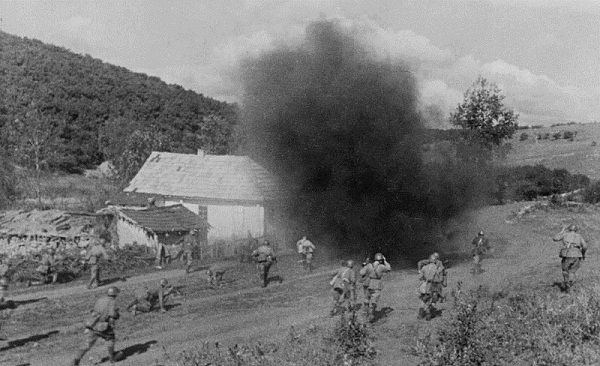
A captured Soviet photo, showing one of the desperate attacks to breakout of the Dniester pocket.
While advances were being made in the south and preparations for more in the north were underway, Army Group Centre stood still. The release of pressure on the Soviet forces, in the centre, allowed them to regain their breath and regroup. Within days of the panzers departing, the Second Battle of Smolensk began. With no reserves, and the line extended to breaking point so divisions were unable to support each other, Soviet forces were able to mass and attack isolated units. By the middle of the month the most north-eastern sector of our line had been driven back, this was followed by a determined assault on what had been the centre of our line north of Smolensk. The infantry put up a determined fight but were simply overwhelmed by the Red Army attacks. A last minute counterattack saved two divisions from being cut off, but this expense of resources isolated Smolensk, which was targeted next. On 20 August, as Soviet troops attempted to retake the city, three divisions still forming were ordered to the Smolensk sector as was three infantry divisions from Army Group North, which were scheduled to take part in the upcoming assault. These new orders were unable to stem the Soviet attacks, and on the 24th the city was abandoned. The newly arrived divisions however halted any further attacks, somewhat stabilising the line and per our doctrinal teachings launched immediate counterattacks. Yet by the end of the month, further tactical withdrawals had to be made to provide some sort of reserve and any chance of holding what had been captured.
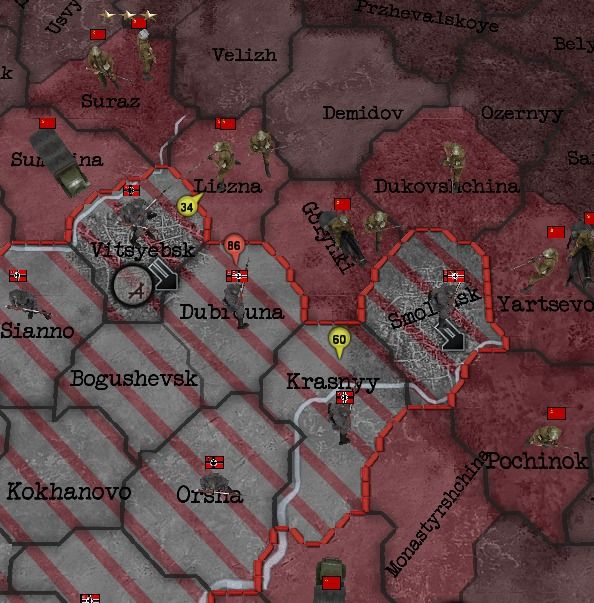
The Second Battle of Smolensk, 22 August
0100 19 August, Army Group North finally launched its offensive. Twenty-Five divisions, out of a total of 42, including Panzer Group 1, 2 and 4 had been concentrated in a small bulge of the line. The main objective of the attack was to secure the Daugava river line, thus trapping all Soviet forces west of it. Due to the amount of armour concentrated in the area, von Both – commanding officer of Army Group North – hoped that the possibility might be created to advance on Tallinn and Pskov thus securing the northern flank of the centre forces. With any retreat route cut off, the army group would then be able to squeeze shut the pocket.

Green: The main assault
Blue: Supporting attacks
Yellow: Proposed subsequent attacks
In the dark, nearly 400 artillery guns, the divisional artillery of eight infantry divisions, opened fire hitting Soviet positions in front of Army Group North. Six divisions attacked: three advancing north and three attacking north by northwest. The armour waited, ready to advance through whichever force created a gap in the line, while a further two infantry divisions formed a solid base the Soviets could not counterattack on. Within hours the latter force had broken through the Soviet lines and the armour was unleashed. The infantry attacking north would carry on their attack, meeting solid resistance and unable to break through, but in doing so they tied down forces that could have been used in a flanking attack.
Once through into the open country beyond, it took the leading divisions five days to travel the roughly 100-miles to Riga, arriving on 26 August. On the outskirts, the panzer wedge was halted by determined resistance from the city garrison. The divisions behind them fanned out capturing various unprotected river crossings along the Daugava, moved to encircle Riga, and advanced both east and west. With a sizeable garrison in Riga, a mass force assembling around Army Group Centre, and the northern Soviet armies undefeated, it was decided to limit any eastern thrusts and concentrate the panzers westwards. With Riga reached, attacks were mounted across the length of Army Group North’s line to start the process of pushing the Soviet forces into a smaller pocket.
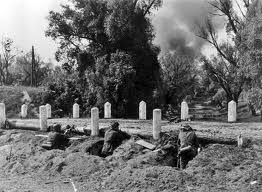
The 'Anvil': troops along the southern edge of the Dniester pocket.
In the south, regardless of the amount of pressure asserted on the Dniester pocket, dug-in Soviet soldiers were mounting a desperate and determined defence that had halted the attack along the northern edges. The daily Soviet attacks made in the south had repeatedly failed to break through, and the blood-letting that was taking place was put forth as the reason for the nearly 80,000 estimated Soviet casualties inflicted during the course of the month. In an attempt to assert more pressure on the pocket, several limited attacks were made west into the pocket that cut it further down to size but were unable to inflict the decisive result hoped for. By months end, facing no opposition the panzers had reached the Black Sea and had entered Odessa.
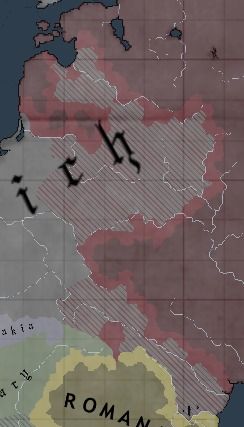
The frontline at the end of the month.
The end of July saw the battle plan for the campaign falter, due to earlier strategic decisions. Unable to support any further advance of Army Group Centre, who were now holding a 400-mile long front, Field Marshal von Rundstedt called its commanding officer during the early hours of 1 August. No record of the conversation exists, but it is believed the aging commander informed von Kluge "The advance is no longer sustainable; you are to halt, hold the line, and relinquish commander of the panzers. There is no room for discussion." Whatever the actual wording of the conversation, various staff officers within the army group have gone on record to say that following the phone call von Kluge was "not in the best of moods". Within the space of a few minutes Army Group Centre, once the strongest formation Germany had put into the field, had been reduced to a mere 24 divisions.
While the termination of Army Group Centre’s advance was a blow to the prestige of von Kluge – with ambitions of co-ordinating the capture of the Soviet capital – it was the correct decision in regards to the strategic situation. All infantry reserves, other than a few divisions still forming within the Reich, had been allocated to Barbarossa and there was nothing left to support the continued drive on Moscow. Under its own power Army Group North was not able to inflict a devastating defeat upon the northern Soviet armies, nor was it able to clear out the Baltic States and secure the flank of Army Group Centre. In an effort to achieve these goals, and shorten the frontline, Panzer Group 1 and 2 would be transferred north. It would however take these 12 divisions two weeks to be relieved, move back into reserve and be available to strike towards the Baltic.

The German attacks along the northern edge of the pocket.
Meanwhile in the south, an untold number of Soviet divisions were still trapped in what had by now become known as the 'Dniester pocket'. Blaskowitz, commanding the southern army group, had created a relatively weak blocking position to the south of the pocket and now assembled 16 divisions (out of the 46 he now controlled) to hammer away at the northern end of the pocket driving the defending Russian troops south into the waiting hands of his 'anvil'. During the first two weeks of the month, this stratagem worked well. Position after position, along the northern ends of the pocket, were captured, and desperate Soviet soldiers launched themselves daily upon the German blocking position that was barring their way to freedom. Two German divisions, dug-in and manning roadblocks with well-sited machine gun and artillery positions, was all that stood between them and escape. On a daily basis, for the entire month, these troops held their position and hammered away at the desperate Soviet forces during attempted breakout. The raising body count did not deter further efforts the next day, or the day after. With the Red Army trapped within the Dniester pocket no longer posing a threat to the corridor, Blaskowitz now launched numerous attacks to expand his frontline and unleashed his panzers south through a gap in the line into undefended territory.

A captured Soviet photo, showing one of the desperate attacks to breakout of the Dniester pocket.
While advances were being made in the south and preparations for more in the north were underway, Army Group Centre stood still. The release of pressure on the Soviet forces, in the centre, allowed them to regain their breath and regroup. Within days of the panzers departing, the Second Battle of Smolensk began. With no reserves, and the line extended to breaking point so divisions were unable to support each other, Soviet forces were able to mass and attack isolated units. By the middle of the month the most north-eastern sector of our line had been driven back, this was followed by a determined assault on what had been the centre of our line north of Smolensk. The infantry put up a determined fight but were simply overwhelmed by the Red Army attacks. A last minute counterattack saved two divisions from being cut off, but this expense of resources isolated Smolensk, which was targeted next. On 20 August, as Soviet troops attempted to retake the city, three divisions still forming were ordered to the Smolensk sector as was three infantry divisions from Army Group North, which were scheduled to take part in the upcoming assault. These new orders were unable to stem the Soviet attacks, and on the 24th the city was abandoned. The newly arrived divisions however halted any further attacks, somewhat stabilising the line and per our doctrinal teachings launched immediate counterattacks. Yet by the end of the month, further tactical withdrawals had to be made to provide some sort of reserve and any chance of holding what had been captured.

The Second Battle of Smolensk, 22 August
0100 19 August, Army Group North finally launched its offensive. Twenty-Five divisions, out of a total of 42, including Panzer Group 1, 2 and 4 had been concentrated in a small bulge of the line. The main objective of the attack was to secure the Daugava river line, thus trapping all Soviet forces west of it. Due to the amount of armour concentrated in the area, von Both – commanding officer of Army Group North – hoped that the possibility might be created to advance on Tallinn and Pskov thus securing the northern flank of the centre forces. With any retreat route cut off, the army group would then be able to squeeze shut the pocket.

Green: The main assault
Blue: Supporting attacks
Yellow: Proposed subsequent attacks
In the dark, nearly 400 artillery guns, the divisional artillery of eight infantry divisions, opened fire hitting Soviet positions in front of Army Group North. Six divisions attacked: three advancing north and three attacking north by northwest. The armour waited, ready to advance through whichever force created a gap in the line, while a further two infantry divisions formed a solid base the Soviets could not counterattack on. Within hours the latter force had broken through the Soviet lines and the armour was unleashed. The infantry attacking north would carry on their attack, meeting solid resistance and unable to break through, but in doing so they tied down forces that could have been used in a flanking attack.
Once through into the open country beyond, it took the leading divisions five days to travel the roughly 100-miles to Riga, arriving on 26 August. On the outskirts, the panzer wedge was halted by determined resistance from the city garrison. The divisions behind them fanned out capturing various unprotected river crossings along the Daugava, moved to encircle Riga, and advanced both east and west. With a sizeable garrison in Riga, a mass force assembling around Army Group Centre, and the northern Soviet armies undefeated, it was decided to limit any eastern thrusts and concentrate the panzers westwards. With Riga reached, attacks were mounted across the length of Army Group North’s line to start the process of pushing the Soviet forces into a smaller pocket.

The 'Anvil': troops along the southern edge of the Dniester pocket.
In the south, regardless of the amount of pressure asserted on the Dniester pocket, dug-in Soviet soldiers were mounting a desperate and determined defence that had halted the attack along the northern edges. The daily Soviet attacks made in the south had repeatedly failed to break through, and the blood-letting that was taking place was put forth as the reason for the nearly 80,000 estimated Soviet casualties inflicted during the course of the month. In an attempt to assert more pressure on the pocket, several limited attacks were made west into the pocket that cut it further down to size but were unable to inflict the decisive result hoped for. By months end, facing no opposition the panzers had reached the Black Sea and had entered Odessa.

The frontline at the end of the month.
Last edited:
It's been tough going against the Soviets but the push in the North and the resulting pocket in the Baltics should go a long way towards victory progress. What sort of tactical air support are you able to employ? Seems like you need a little extra oomf to right things in the South (and Center for that matter). Are there any builds currently taking place to reinforce Barbarossa? My general impression is you're sorely needing more troops (maybe an oversimplification...but I'm curious). Glad to see an update...nice job enigmamcmxc.
The general plan i have in mind at the moment is to destroy that northern pocket, then switch my forces to tackle that southern bulge.
I feel like i have had a major shortage of troops since the start of the game. I focused on the industrial and air power side of things, then started to build up my forces and when i did that i initially went for garrison troops. I wanted enough to guard my border with France, who could later take up the occupation as they did. But, in doing so it seems i screwed myself over in terms of time to build up my regular infantry.
I have 13 infantry divisions being built at the moment, all on serial production to keep pumping them out every few months. I have somewhere between 6 and 9 divisions sitting in Germany, waiting for there organisation to increase, before i move them forwards. I also plan on building at least 13 more panzer divisions (i think am building 3 atm) to bring me to the historical level (so that is 3 SS, 1 Luftwaffe, 21-27 pz, 116, and Pz Lehr, all on top of what i have). In addition i am building a few cav divisons for occupation purposes.
In terms of air support, my forces are suffering from low organisation and i doesnt really matter if i spread them out or not - there doesnt seem to be enough airfields to support what i have. I have cleared the skies of Red Air Force fighters so i have stood down my CAP. Half of my medium bombers are hitting the southern pocket, while the rest need reinforcing or there organisation to increase. All that really leaves is my light bombers to support the north, but again there organisation is really low.
I feel like i have had a major shortage of troops since the start of the game. I focused on the industrial and air power side of things, then started to build up my forces and when i did that i initially went for garrison troops. I wanted enough to guard my border with France, who could later take up the occupation as they did. But, in doing so it seems i screwed myself over in terms of time to build up my regular infantry.
I have 13 infantry divisions being built at the moment, all on serial production to keep pumping them out every few months. I have somewhere between 6 and 9 divisions sitting in Germany, waiting for there organisation to increase, before i move them forwards. I also plan on building at least 13 more panzer divisions (i think am building 3 atm) to bring me to the historical level (so that is 3 SS, 1 Luftwaffe, 21-27 pz, 116, and Pz Lehr, all on top of what i have). In addition i am building a few cav divisons for occupation purposes.
In terms of air support, my forces are suffering from low organisation and i doesnt really matter if i spread them out or not - there doesnt seem to be enough airfields to support what i have. I have cleared the skies of Red Air Force fighters so i have stood down my CAP. Half of my medium bombers are hitting the southern pocket, while the rest need reinforcing or there organisation to increase. All that really leaves is my light bombers to support the north, but again there organisation is really low.
Nice going in the Armee Group North....It would be nice to eliminate that Dneister pocket of Russkies to free up more Divisions....A big bag of troops is sitting inside of that big bulge in the middle....Now if you could bag them too that would probably make the Soviet bear reel on his back legs....
Hey all, i will be posting an update later which will most likely be the last for a while. Next week, if things go according to plan, i will shortly be moving and it may be a few months before i am up and running again.
That huge haul of prisoners no longer appear to want to sit still and await me to launch the Battle of Kiev Time is running out and my enemies are mounting.
Time is running out and my enemies are mounting.
That huge haul of prisoners no longer appear to want to sit still and await me to launch the Battle of Kiev

